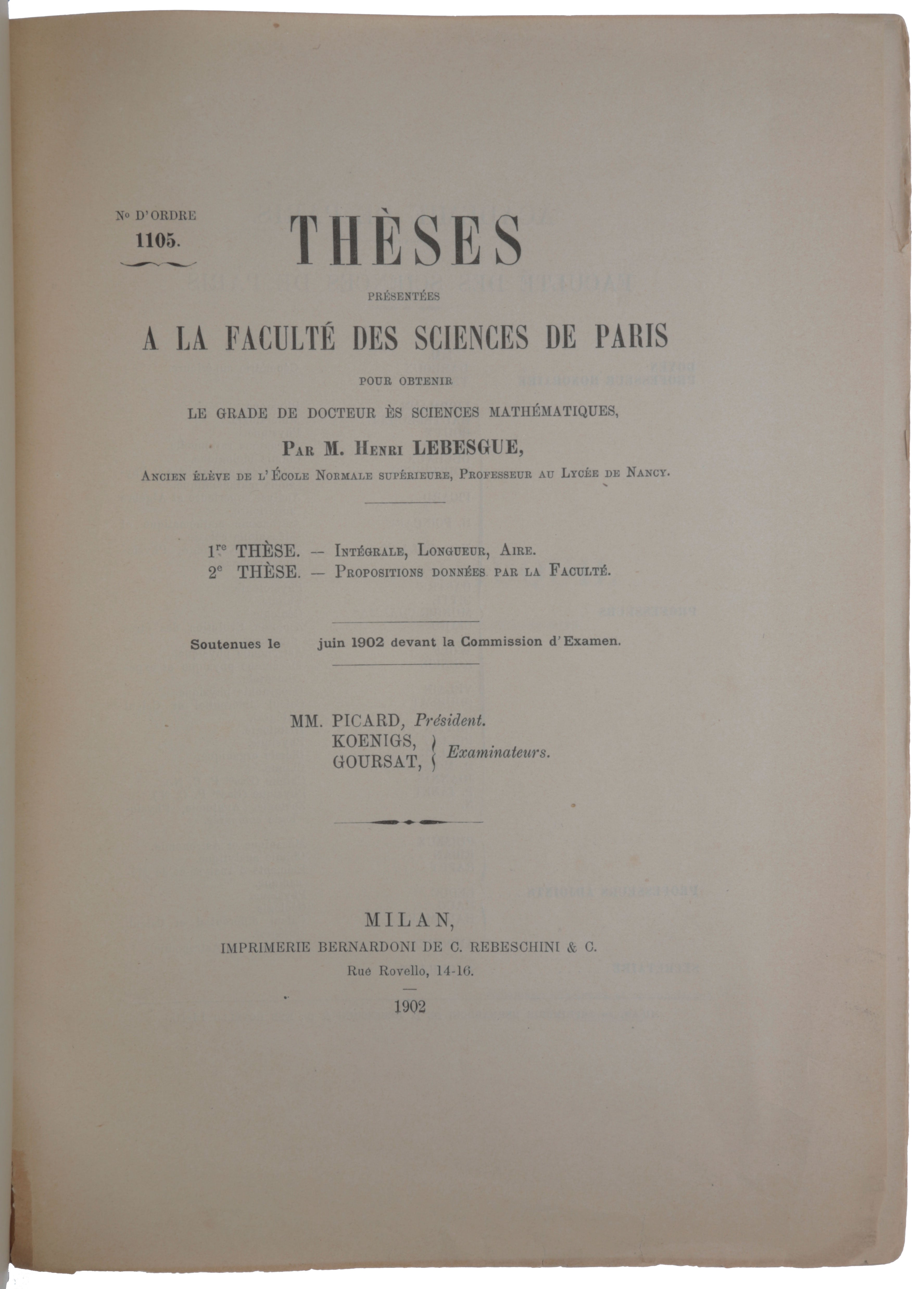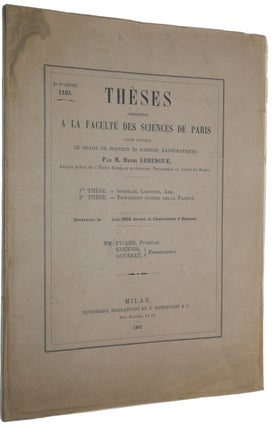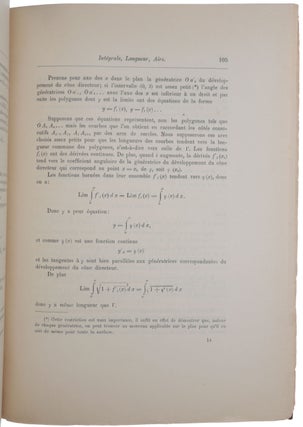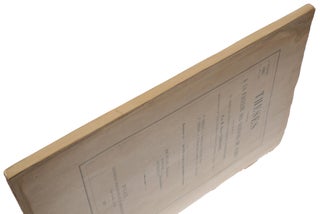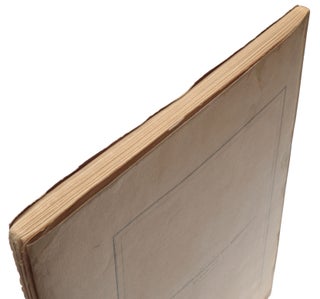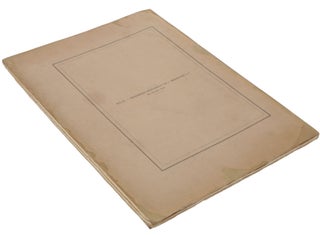Thèses présentés a la Faculté des Sciences de Paris pour obtenir le Grade de Docteur...1re Thèse. Intégrale, Longueur, Aire. 2e Thèse. Propositions données par la Faculté.
Milan: Imprimerie Bernardoni de C. Rebeschini, 1902. First edition, very rare, of “Lebesgue’s great thèse” (Burkill, p. 484), describing his new theory of integration, now known as the ‘Lebesgue integral’. “The Lebesgue integral is one of the great achievements of modern real analysis” (Britannica). “It cannot be doubted that this dissertation is one of the finest which any mathematician has ever written … [Lebesgue’s] work lay almost entirely in one field—the theory of real functions; in that field he is supreme” (Burkill, pp. 484 & 488). “Lebesgue’s outstanding contribution to mathematics was the theory of integration that bears his name and that became the foundation for subsequent work in integration theory and its applications ... [In his doctoral thesis] Lebesgue began to develop his theory of integration which, as he showed, includes within its scope all the bounded discontinuous functions introduced by Baire” (DSB VIII: 110). “Building on the work of others, including that of Émile Borel and Camille Jordan, Lebesgue formulated the theory of measure in 1901 and in his famous paper ‘Sur une généralisation de l’intégrale définie’, which appeared in the Comptes Rendus on 29 April 1901, he gave the definition of the Lebesgue integral that generalises the notion of the Riemann integral by extending the concept of the area below a curve to include many discontinuous functions. This generalisation of the Riemann integral revolutionised the integral calculus. Up to the end of the 19th century, mathematical analysis was limited to continuous functions, based largely on the Riemann method of integration … What made the new definition important was that Lebesgue was able to recognise in it an analytic tool capable of dealing with — and to a large extent overcoming — the numerous theoretical difficulties that had arisen in connection with Riemann's theory of integration. His contribution is one of the achievements of modern analysis which greatly expands the scope of Fourier analysis” (MacTutor). Following the brief announcement of his theory in the Comptes Rendus, Lebesgue’s thesis was published in its complete form in the offered work. It was also published in Annali di Matematica 7 (1902), 231-359, and the substance of the thesis formed part of his Leçons sur l’Intégration et la Recherche des Fonctions Primitives (1904) (where it is preceded by a 98-page historical introduction). OCLC locates only two copies of the thesis in America; no copies in auction records. “Towards the close of the last century, the development of mathematical analysis may be said broadly to have reached the stage at which a piece of work wherein only continuous functions were encountered could be carried through. For example, the Riemann integral solved the problem of finding a function having a given derivative if the derivative was continuous. Again, everything was known about the length of a curve and its expression as an integral if it had a continuously turning tangent. Artificial and unaesthetic restrictions had repeatedly to be made to keep out discontinuous functions. Camille Jordan, in the preface to his Cours d’Analyse (2nd edition, 1893), wrote: ‘Certains points présentent encore quelque obscurité. Pour en citer un exemple, nous n’avons pu arriver à définir d’une manière satisfaisante l’aire d’une surface gauche, que dans le cas où la surface a un plan tangent, variant suivant une loi continue’. In 1898 vital steps were taken by Baire and by Borel. The thèse of Baire was a systematic and penetrating discussion of discontinuous functions. And Borel in the small compass of four pages of his tract, Sur la théorie des fonctions, propounded his theory of measure, fundamentally more powerful than Jordan’s theory of content in being additive for an enumerable infinity of sets. All was ready for the rapid advances of the next decade which made the theory of real functions into a satisfying whole; in this transformation the leading part was played by Lebesgue” (Burkill, p. 483). There was a fundamental problem with the theory of integration put forward by Bernhard Riemann in the mid-19th century – Riemann’s integration and differentiation are not completely reversible, contrary to the principle that integration and differentiation are ‘inverse’ operations. More precisely, towards the end of the century functions f(x) had been found which had a bounded derivative f’ = df/dx everywhere, but for which f’ was so highly discontinuous that it could not be integrated using the Riemann integral. Thus, the process of differentiation could not always be ‘undone’ by subsequent integration. Lebesgue addressed this problem by defining the integral in a new way, which allowed the integration of functions which were outside the scope of the Riemann integral. Between June 1899 and April 1901, Lebesgue published five notes in the Comptes Rendus which “deal with matter incorporated in the thèse published in 1902, and they are of great interest as showing the succession of ideas that led to the formulation of the Lebesgue integral. The first of the five notes puts the problem of what surfaces are ‘applicable to a plane’—in the sense of a one-one correspondence such that any rectifiable curve of the surface is transformed into a rectifiable curve in the plane of the same length. Ossian Bonnet had proved that, on the assumption of a continuously turning tangent plane, the only such surfaces were developables. Here was a problem of which the general solution plainly required a release from the shackles of continuity. Lebesgue remarks ‘combien la forme des surfaces physiquement applicables sur le plan, comme celles que l’on obtient en froissant une feuille de papier diffère de la forme des surfaces développables’. This note, breaking away from the conventions of classical differential geometry, is said to have ‘scandalise Darboux’. “In the next note the area of a skew polygon C is defined as the lower bound of the areas of polyhedral surfaces having C as boundary; then the area of a skew curve by means of inscribed polygons approaching it; finally the area of a surface by dividing it up by a network of curves. The next two notes deal with surface integrals (not Lebesgue integrals!) and the problem of the surface of minimum area with a given bounding contour. “The final note gives the definition of the Lebesgue integral of f(x) by subdividing the range of variation of f(x) instead of the range of x. Some properties are stated, including that of integrating every bounded derivative and—a result belonging to the train of thought of the other notes—the formula for the length of a curve x = f(t), y = φ(t), z = ψ(t), assuming only that [the first derivatives] f’, φ’, and ψ’ are bounded. “Lebesgue’s great thèse, with the full account of this work, appeared in the Annali di Matematica of 1902 [and separately as the offered work]. The first chapter develops the theory of measure—in a more general form than Borel had given it—by assigning outer and inner measures to a set. In the second chapter we have the integral, defined first geometrically (for positive f(x)) as the two-dimensional measure of the set of points (x, y) where 0 < y < f(x) and x is in the range of integration; then follows the analytical definition already mentioned. All the leading properties of the integral are there, with the exception of the theorem that F’ = f almost everywhere [where F is the Lebesgue integral of f], which followed in [a note of 1903]. Double integrals are included and effectively the theorem now known as Fubini’s [that in a double integral it is immaterial which integration is performed first]. The next chapters expand the Comptes Rendus notes dealing with length, area and applicable surfaces, and there is a final chapter on Plateau’s problem, that of finding a surface of minimum area with a given contour” (Burkill, p. 484). “Henri Lebesgue (1875-1941) was only four years younger than Émile Borel (1871-1956). He was born on May 28, 1875, as the son of a print worker and a primary school mistress in Beauvais. By means of a scholarship from this community, he was able to attend secondary school. This was followed by his mathematical education in a period which was dominated by Jordan’s Cours d’analyse and the breakthrough of set-theoretical methods in the treatment of analysis. Between 1894 and 1897 he studied at the École Normale — thus it is possible or even probable that he attended Borel’s lectures. “Subsequently he taught mathematics at a girls’ secondary school in Nancy; but at the same time he finished his doctoral thesis Intégrale, Longueur, Aire, which was defended and published in 1902. [Its starting point was] the impossibility of finding a primitive [i.e., an integral] for certain derivatives in the framework of Riemann’s notion of the integral. “After his graduation, Lebesgue embarked upon an academic career. First he worked in Rennes and Poitiers until he became lecturer at the Sorbonne in 1910, where he became a professor in 1919. From 1921 he taught at the Collège de France, where he stayed for the rest of his life (he died on July 26, 1941). During this time he began to consider mainly pedagogical questions and the history of mathematics. His notion of the integral— which at first was accepted only with hesitation— finally succeeded. Its significance for applications, especially for the analysis of discontinuous and statistical phenomena in nature, soon could not be ignored any longer. Besides other applications, it thus became an important tool in the modern theory of probability” (Jahnke, p. 284). “One of the greatest mathematicians of his day, Lebesgue made an important contribution to topology with his covering theorem (which helps define the dimension of a set). He also worked on Fourier series and potential theory, but his main work was on integration theory” (Britannica). Burkill, ‘Henri Lebesgue 1875-1941’, Obituary Notices of the Fellows of the Royal Society 4 (1944), pp. 483-90. Jahnke, A History of Analysis, 2003.
Tall 8vo (297 x 217 mm), pp. [iv], 129, [1], uncut and mostly unopened. Original printed wrappers laid down on later stiff wrappers (a few marginal chips not affecting printed area).
Item #5821
Price: $6,500.00

